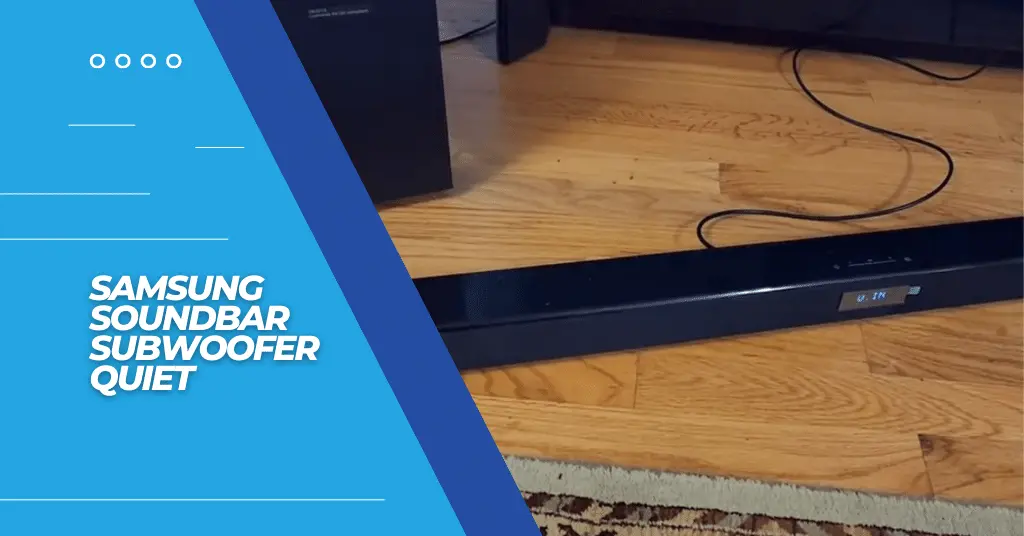Samsung Soundbar Subwoofer Quiet

The Samsung soundbar subwoofer is popular among audiophiles for its sleek design and impressive sound quality. However, many users have reported to me that the subwoofer is quieter than expected, potentially diminishing the overall sound experience.
In this guide, I’ll discuss possible reasons for this reduction in sound volume and offer troubleshooting tips and solutions to enhance your listening experience with the Samsung soundbar subwoofer.
Ultimately, I aim to ensure that your Samsung soundbar subwoofer performs to its optimal capability, providing a rich and immersive audio experience for all your entertainment needs. Let’s begin!
Why Is My Samsung Soundbar Subwoofer Quiet?

Many reasons, such as signal interference, incorrect audio settings, subwoofer placement, firmware issues, or hardware, can cause Samsung soundbar subwoofer quietness problems. In this case, you should start troubleshooting, checking connections, adjusting settings, and updating firmware. However, you may ask for professional help in the worst scenarios.
Top Reasons for Your Samsung Soundbar Subwoofer With No/Low Volume:
Here are the top reasons that I have found while handling the errors in my clients’ Samsung soundbar subwoofers:
1. Interference and Signal Loss:
Interference and signal loss can disrupt the seamless connection between the soundbar and subwoofer. This can happen due to other electronic devices’ interference, poor wireless network, or physical obstructions.
Consequently, the weakened signal manifests as low or no volume from the Samsung soundbar’s subwoofer, compromising the overall output audio.
2. Incorrect Audio Settings:
Many newbies have to face such a problem. They don’t know how to adjust the subwoofer volume on the Samsung system. Therefore, incorrect output audio setting can underpower the subwoofer, making it sound quiet.
By default, the subwoofer level is set too low, or the crossover frequency is not high enough, thereby limiting the range of sound frequencies sent to the subwoofer for reproduction.
3. Firmware or Software Issues:
Samsung keeps optimizing its software to ensure optimal performance. Therefore, outdated firmware or software issues can also cause quietness in a Samsung soundbar subwoofer by disrupting signal processing.
Outdated software might not effectively decode audio input, leading to decreased output volume.
4. Subwoofer Placement and Obstructions:
In some scenarios, I have also noticed that placing the woofer away from the Samsung soundbar may also cause decreased volume due to the incompatible wireless connectivity between them.
The official Samsung has raised this issue too. Moreover, when you place a subwoofer in a corner or obstructed by furniture, the low-frequency waves can get absorbed, causing decreased bass output. The space reduces sound clarity and volume.
5. You Might Have Set the Volume Level Too Low:
Sometimes, you set the volume too low accidentally without knowing the result. I’ve analyzed this error when users try to set up their system or usage and end up lowering the woofer volume too low.
6. Incorrect TV’s Audio Settings/Configuration:
Modern TVs come with advanced functionalities that can adjust the sound systems even for external devices. In those cases, the incorrect TV audio settings can cause Samsung soundbar subwoofer quietness either through the improper selection of audio output, incompatible audio format, misadjusted volume leveling or dynamic range control, altered equalizer settings reducing bass frequencies, or audio delay causing synchronization issues.
7. Hardware Malfunction:
Hardware malfunction can also lead to low or no volume in Samsung’s soundbar subwoofer, impairing its sound-producing capabilities.
Faults in critical components like the amplifier or driver can hamper sound transmission. Additionally, issues in the circuit board or loose wiring can also lower the volume, resulting in a quieter sound output.
Troubleshooting Steps to Improve Subwoofer Volume:
If I were in your shoes, I would have followed the below steps to eliminate the Samsung soundbar subwoofer quiet problem:
1. Turn Up the Volume for Both Soundbar & Subwoofer:
First of all, let’s start with adjusting the volume level on both the Samsung woofer and soundbar. If you have connected the Samsung sound system to your TV, take the TV’s volume to 60+ before adjusting the volume on the soundbar and woofer.
Once done, follow the below steps:
- You can use the Samsung remote control to turn up the volume of the Soundbar. On remote, there will be a Vol+ which you have to press at least ten times.
- However, depending on your Samsung subwoofer, you will find the woofer Vol+ button on the remote or either on the subwoofer itself. Once pressed, it will show the figure between “-6” to “+6” where -6 is the lowest volume and +6 is the highest volume.
- In some Samsung subwoofer models, you must press and hold the woofer button for at least 2 seconds. It will pop up a display “0” by default setting. However, you can push up from the bottom of the woofer button (it’s like a joystick, it can go up and down). Each time you push up, the number increases by 1.

2. Checking Power and Connectivity:

Sometimes, I have fixed the problem by checking the devices’ power and connectivity. Power issues could stem from the device not being plugged in or the power cord not providing sufficient power.
Connectivity problems might arise from loose cables, or in wireless setups, from the subwoofer being too far from the soundbar. Correcting these factors will ensure optimal power supply and signal transmission, thereby potentially fixing the quietness issue.
3. Verifying Audio Input and Source:
Now, let’s verify your audio input and source ensures to see if the soundbar receives the correct signals from the source device. If there’s a mismatch, the subwoofer may produce a quieter sound.
The HDMI connection is crucial, too, as it carries high-quality audio signals. If your HDMI port connection is loose or defective, this could result in decreased subwoofer volume.
4. Adjusting Soundbar and Subwoofer Settings:
I was literally shocked when I fixed the problem just by adjusting the soundbar and subwoofer settings. The sound balance becomes optimized by increasing the subwoofer’s volume and finetuning the soundbar’s EQ, low-frequency, and treble settings.
This ensures that the subwoofer and soundbar work in harmony, thus delivering improved sound quality and overcoming the problem of the subwoofer’s quietness.
5. Ensuring Proper Subwoofer Placement:

Sometimes, you should provide proper subwoofer placement to help connectivity between the wireless devices. If you have models like Samsung Q950, placing it near the front of the room enhances the low-frequency and allows it to travel more effectively.
Corners or enclosed spaces can cause the bass to be muffled, reducing the overall volume. You should keep experimenting with various placements that will allow you to find the sweet spot that provides the best bass output and solves the problem of quietness.
6. Ensuring Your TV Audio Settings:
I am unsure if this will work for you as I don’t know about your TV model. Because every TV model has its own setting display, therefore, you should check your TV’s manual guide. However, these below steps will help you to adjust the TV audio settings:
- Audio Output Selection: You can access your TV’s settings menu and look for the audio or sound section using the TV remote. There, you should choose the appropriate output audio option. In the case of a Samsung soundbar subwoofer, select the “External Speaker Output” or “Soundbar” as the output audio.
- Audio Format and Bitstream Settings: You can further optimize the sound quality by choosing the correct audio formats, like Dolby Digital Audio or DTS. You can select “Bitstream” or “Pass-Through” to allow your soundbar to decode the audio signal. If your soundbar doesn’t support such an audio format, select “PCM” or “Stereo.”
- Volume Leveling and Dynamic Range Control: Modern TVs come with advanced volume leveling or dynamic range control features. However, I have found them helpful in specific scenarios as they might affect the overall output audio, including the subwoofer’s volume.
- HDMI-CEC (Anynet+): If your TV and soundbar support HDMI-CEC (Samsung’s Anynet+), enable it to allow seamless soundbar control using the TV remote. This simplifies the overall user experience.
7. Updating Firmware and Software:

Updating your Samsung soundbar’s firmware can resolve issues with the subwoofer’s volume. A volume-related problem could be caused by a software glitch that the manufacturer has addressed in a newer update.
To update your Samsung soundbar’s firmware, you’ll need a USB flash drive and a computer with an Internet connection. First, visit the Samsung support website and navigate to the page for your specific soundbar model.
Look for a section labeled “Firmware” and download the latest version to your computer. Once downloaded, extract the files and copy them onto your USB flash drive.
Plug this into your soundbar, and use the remote to navigate to the ‘Software Update’ option in the settings menu. Select ‘Update Now’, and your soundbar will install the new firmware. Once the update is complete, check whether the subwoofer volume has improved.
8. Reset the Factory Settings:
General FAQs
What Are the Ideal Placement Options for a Samsung Soundbar Subwoofer?
The ideal placement for a Samsung soundbar subwoofer is in the front of the room, in either corner and at least one foot from the wall. This ensures optimal resonance and sound distribution.
Can I Use Third-Party Sound Enhancer Devices With My Samsung Soundbar?
Yes, you can integrate third-party sound enhancer devices with your Samsung soundbar. However, ensure compatibility beforehand to avoid potential audio issues or device damage.
Why Does My Subwoofer Sometimes Produce Distorted Sound?
Your Samsung subwoofer sound distortion often results from placing it away from the soundbar, as it may disrupt the signal strength between them.
